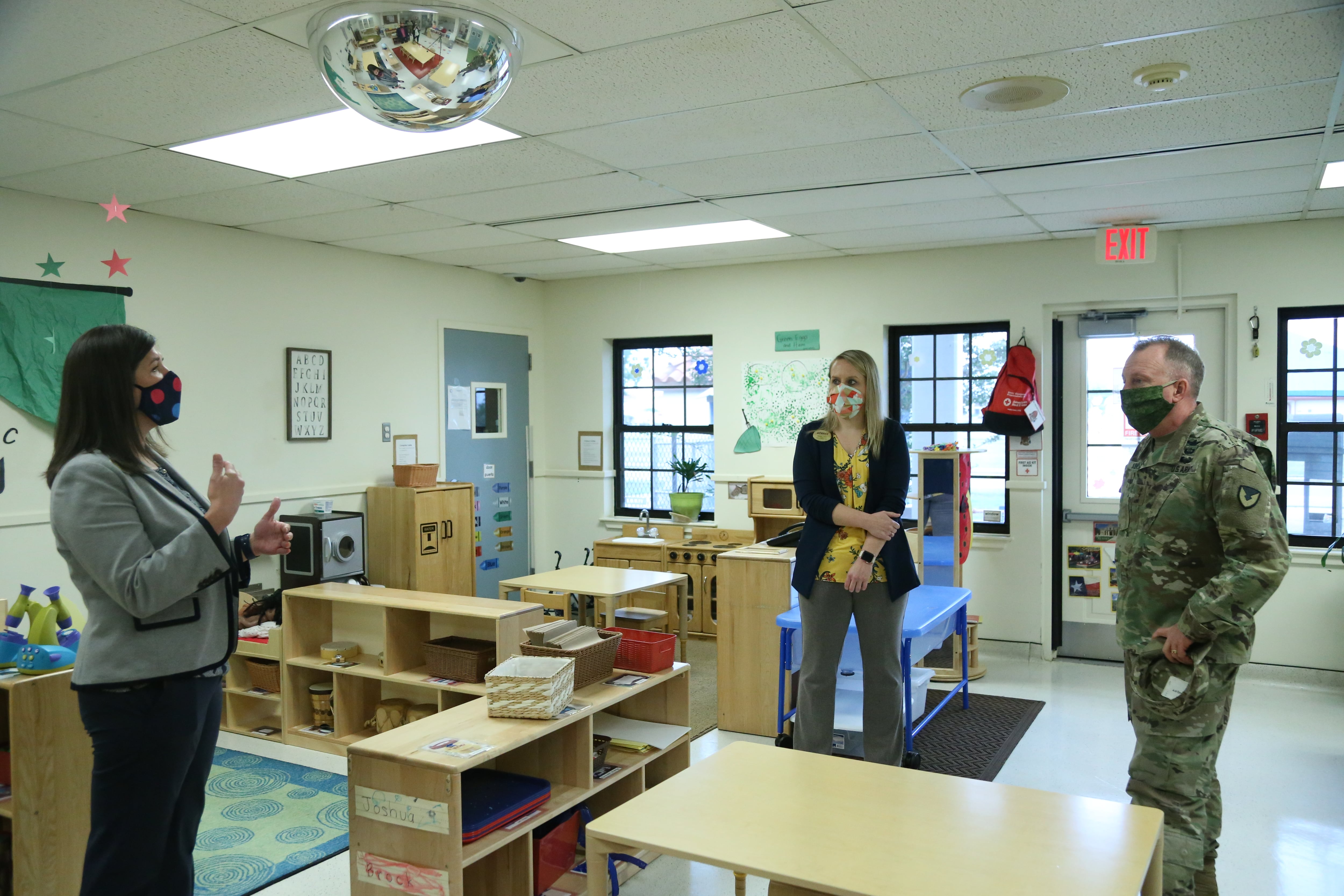This story has been updated with recent statistics.
Even as Army officials try to mitigate the impact of COVID-19 on the quality of life of soldiers and families, they’re looking beyond the pandemic in their continuing efforts to improve quality of housing, child care capacity, permanent change of station moves and better employment opportunities for spouses.
“We understand our strengths and weaknesses. We know we have gaps. … But we have a pretty good grasp of the data that helps us inform some decisions that we make,” said Lt. Gen. Douglas Gabram, commander of the Army Installation Management Command. He took command on Jan. 22, 2020, just before COVID hit.
“We as a team are committed to making it better for our soldiers, civilians and families,”
Here are some of the efforts.
Housing
Gabram and his team are tracking maintenance work orders at each installation. In anticipation of the COVID dangers, before the nationwide shutdown in March, officials decided to limit maintenance in soldiers’ homes to those issues affecting life, health and safety, “because folks didn’t want maintenance workers in their homes if they didn’t need to go in there,” he said.
Residents have been emailing photos of maintenance issues for evaluation. For minor maintenance issues, like changing air filters, maintenance experts have been connecting to residents via video calls to walk them through the replacement procedures. They’ve also provided supplies to help residents take a more active role in maintaining their homes. In August, housing companies started tackling the backlog of work orders that had been put on hold because of COVID, and in general that work order situation “is in pretty good shape” now, Gabram said.
They’re also tracking the number of families who are displaced from their homes because of mold and other issues. As of Jan. 22, there were 66 displaced families on Army installations, out of 87,133 residences, with 38 of those being pre-planned to facilitate renovations. Thus, Gabram notes, 0.003 percent of residents in privatized housing are currently displaced for unplanned repairs.
“I want it down to none, but we were a little over the 200 mark when we first started this” a year ago, he said. Each Monday, he meets (virtually now) with garrison commanders of installations where there are displaced families, alongside their privatized housing partner, to discuss each family — when and why they were displaced, when they’re moving back into the house and the repair plan.
“We’re in a completely different situation than we were a year ago,” he said, referring to the housing crisis involving mold, rodent infestations and other problems. “We all can agree that the Army and the [privatized housing] companies took our eye off the ball.”
Officials at higher levels in the services and the DoD are now working with the companies to iron out the final provisions of the tenant bill of rights for housing residents.
Officials are also finalizing plans to pump more money into housing. In October, former Secretary of the Army Ryan McCarthy announced a $2.5 billion housing improvement effort over the next five years that involves both reinvestment and new capital, primarily spearheaded in the beginning by the Lendlease and Balfour Beatty companies. “That will make a huge difference at multiple installations,” Gabram said. “Fort Hood is one of those,” with several million dollars going into housing at the Texas installation.
PCS moves
The Army is putting together “PCS Summer Surge 2.0”, applying lessons learned this year during the pandemic in the hope of improving moves in the summer of 2021.
Soldiers made about 72,000 household moves during the June-through-September compressed PCS cycle following the stop movement order in the spring. More than 97 percent of those moves were inspected in person by a quality assurance inspector, surpassing the DoD requirement. The customer satisfaction rate was 94.5 percent for Army moves in the period from Jan. 1 through Sept. 20, Gabram said.
In 2019 Gen. Gus Perna, then-commander of the Army Materiel Command, ordered a study of the three small installations with the highest turnover rate — Carlisle Barracks, Fort Leavenworth and Fort Bliss. The goal was to improve the quality of moves by looking at transportation, personnel, orders, household goods and maintenance on the homes between occupants.
“If we could improve the quality of all those things, we’d have a much better quality move,” Gabram said. “We had this in place, and then what happened? COVID hit.” So their plan moved up to Army headquarters for use on a broader scale.
One change is to try to get orders to most soldiers 120 days before their report date, giving them and their families more maneuvering space to deal with household goods, schools, housing and the myriad other elements of a move.
Child care
Before COVID hit, Army child development centers had a capacity of 19,557 children, which fell short of the needs of Army families. Recognizing that shortage of child care spaces, Army officials established a facilities investment plan, Gabram said. The 10-year strategy involves 21 funded projects that will provide an additional 4,300 child care spaces.
A new requirement gives military families priority in child development centers, which, in effect, adds more spaces. Since Sept. 1, when the DoD requirement took effect, Army installation CDC officials have given 516 supplanting notices to lower priority families, giving them 45 days notice that their space is needed for a higher priority family. Out of the 470 who have been actually supplanted as of Jan. 11, 433 were civilian families and 37 active-duty families have been supplanted by a higher-priority family, Gabram said. Officials have done a review of the supplanting data, garrison by garrison.
Senior division commanders and garrison commanders have the authority to grant exceptions to policy, depending on the situation.
Individual CDC capacity is affected by the installation’s health protection condition. As of Jan. 11, there were 137 out of 171 Army child development centers open, based on local health protection conditions. With COVID-induced requirements, there are also fewer children allowed in a room. In some cases, parents have chosen not to put their children in child care during COVID for a variety of reasons, Gabram said.
“You can’t social distance children,” Gabram said. The lowest capacity the CDCs went to was 25 percent, in March and April, but they didn’t close, because of mission requirements, he said.
“At CDCs, we get hit every day in terms of [positive COVID cases], but we’re pretty good about mitigating the risks, closing the minimal amount of rooms, minimizing the impact to the mission, and messaging the parents and chain of command appropriately.
“We’re very proficient and effective in executing our mission in a COVID environment. If it gets worse, we’re prepared for that, because that’s what we do. Our installations work through it. We were getting through it when others weren’t.”
Spouse employment
Like the other service branches, the Army has a number of programs designed to increase employment and education opportunities for spouses.
In 2020, Army officials streamlined the process for spouses who want to operate home-based businesses on installations. Now, officials at Morale, Welfare and Recreation “escort” a spouse through the administrative and legal process, cutting the approval time. Of the 616 home-based businesses on Army garrisons, 471 are operated by spouses, and that doesn’t include family child care homes.
Spouses who are employed in non-appropriated fund activities now have access to the Civilian Employment Assignment Tool, helping them continue employment as they transfer to another duty station. As of Dec. 30, 1,173 people have been registered and 449 have been transferred to new jobs, of which 259 are military spouses, Gabram said.
Karen has covered military families, quality of life and consumer issues for Military Times for more than 30 years, and is co-author of a chapter on media coverage of military families in the book "A Battle Plan for Supporting Military Families." She previously worked for newspapers in Guam, Norfolk, Jacksonville, Fla., and Athens, Ga.





